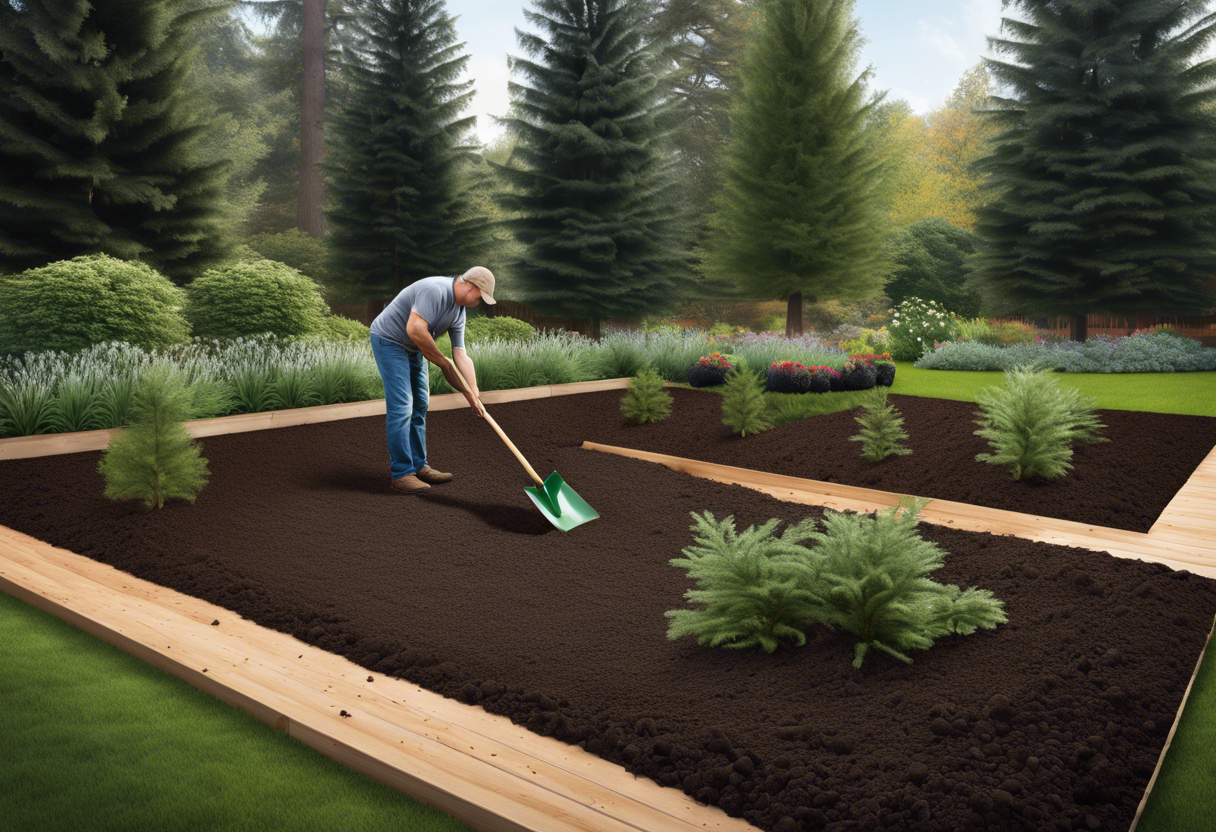Ever tried to Grow Hostas under Pine Trees? If you’re like me, the first time I attempted this, it was a bit of a disaster. I mean, who knew that these leafy beauties could be so finicky about their living conditions?
But don’t worry! After many trials and even more errors, I’ve got some tips and tricks up my sleeve to help your hostas thrive under those pine trees. Keep reading about 5 Tips to Grow Hostas under Pine Trees Successfully!
Key Takeaways
- Choose hosta varieties that can tolerate acidic soil, as pine trees make the soil more acidic.
- Improve the soil by adding organic matter and compost to provide nutrients for the hostas.
- Ensure adequate watering, as pine trees tend to absorb a lot of water from the soil.
- Provide enough sunlight for hostas, they need at least a few hours of morning sun.
- Regularly check for pests and diseases, especially slugs which are common in shady areas under pine trees.

Understanding the Environment
To grow hostas under pine trees successfully, it’s crucial to understand the environment they’ll be living in. We’re talking about the nature of pine trees, soil conditions, and light requirements.
The Nature of Pine Trees
Pine trees are tall fellas with a knack for creating a dense canopy. This characteristic can significantly impact how your hostas grow beneath them. The thick foliage can limit sunlight and rainfall reaching the ground below, making it a bit tricky for our shade-loving hosta plants.
But don’t fret! Hostas are tough cookies that can adapt to these conditions. They’re like those folks who thrive in high-pressure jobs – they just need the right care and attention.
Soil Conditions under Pine Trees
Now let’s talk dirt – literally! The soil under pine trees tends to be acidic due to falling needles decomposing over time. This might sound like bad news for some plants but not for hostas. These guys are pretty chill about soil pH levels.
However, what they do care about is well-drained soil. So if you’ve got heavy clay or compacted earth under your pines, you might need to work on improving those soil conditions before planting your hostas there.
Light and Shade Requirements for Hostas
Hostas have this cool thing going where they love shade but also need some light. It’s like their version of having their cake and eating it too!
Growing them under pine trees provides an ideal balance between light and shade. The tree canopy filters harsh sunlight while still allowing enough through for the hostas’ needs.
Remember though, not all hosta varieties have the same light requirements. Some prefer more shade than others so choose wisely when planning to grow hostas under pines.
Preparing the Planting Site

When it comes to growing hostas under pine trees, site preparation is key. It involves cleaning the area, improving soil quality, and ensuring proper drainage.
Cleaning the Area
First things first, you gotta clean up your act – or rather, your hosta planting site. You see, hostas are a bit like the divas of the garden world. They don’t like sharing their space with debris or other plants that could steal their nutrients and sunlight. So grab your gardening gloves and start clearing that space under your pine trees.
But wait! Don’t just start ripping out everything in sight. Be gentle with your ground prep. Remember, we’re preparing for a star performance here – not a demolition derby!
Improving Soil Quality
Now let’s talk dirt. Or more specifically, how to make it perfect for our hosta divas. Hostas love rich soil with plenty of organic matter. So consider adding some compost or well-rotted manure to enrich your garden soil.
And remember those pesky pine needles? Well turns out they can actually help us here by making the soil slightly acidic – just how our hostas like it! But don’t go overboard; keep an eye on that pH level to ensure it stays within the sweet spot for hostas.
Ensuring Proper Drainage
Finally, let’s tackle water management because no one likes soggy feet – especially not our hosta divas! Waterlogged soil is a big no-no when trying to grow hostas under pine trees.
So how do we avoid this? By ensuring proper drainage in our planting site of course! This could mean adding grit or sand to heavy soils or creating raised beds if necessary.
Remember folks, dry roots are happy roots when it comes to hostas! So let’s keep them high and dry to avoid any root rot drama.

Choosing the Right Hosta Varieties
When it comes to growing hostas under pine trees, picking the right variety is a biggie. It’s like choosing the right outfit for a party – you gotta consider size, growth habit, leaf color and texture. Trust me, your hosta selection guide should be as detailed as your shopping list.
Size and Growth Habit Considerations
Now, let’s talk about size. You wouldn’t wear oversized shoes to a dance-off, would you? Same goes for choosing right-sized hostas. Some varieties grow larger than others, so consider how much space you have under those pines before making a decision.
And then there’s growth habit. Some hostas are like teenagers – they spread out everywhere! Others are more compact and well-behaved. Understanding these hosta growth patterns can help ensure your plants don’t end up wrestling each other for room under the tree.
Leaf Color and Texture Preferences
Moving on to leaf color and texture. Think of these as the accessories that complete your outfit. The hosta leaf color variations range from cool blues to vibrant yellows and everything in between. Picking colors that pop can really make your garden stand out.
Texture is another important factor to consider when deciding which hostas to plant under pine trees. Some have smooth leaves while others sport corrugated or wavy foliage. These different textures can add depth and interest to your garden scene.
So there you have it folks! Remember, when trying to grow hostas under pine trees, picking the right variety is half the battle won!
Planting Hostas under Pine Trees
When it comes to pine tree gardening, there’s a knack to it. You see, the secret to healthy hosta growth lies in the planting. Yep, you heard me right! It’s all about the depth and spacing when you’re planting hostas.
Correct Spacing for Healthy Growth
Now, let’s talk about spacing. If you want your hostas to thrive under those pine trees, you’ve gotta give ’em room to breathe. Think of it like this: each hosta is a superstar that needs its own personal space on stage.
The optimal plant spacing isn’t just about aesthetics; it’s crucial for promoting healthy growth. Too close together and they’ll be fighting for nutrients like kids over candy! So remember folks, when gardening under pine trees, keep those hostas spaced out!
Depth of Planting
Alrighty then, onto depth. The proper planting depth can make or break your hosta game. Dig too shallow and your hostas might dry out faster than a raisin in the sun! But dig too deep and they could drown.
The key here is understanding the hosta root system. These guys aren’t deep divers; they prefer staying near the surface where they can soak up water and nutrients easily. So when you’re ready to plant, aim for a depth that keeps most of their roots in the topsoil.
There you have it folks – a crash course in successful garden planting! Remember these tips next time you’re looking to grow Hostas under Pine Trees, and watch them flourish!
Maintaining Your Hostas
When it comes to growing hostas under pine trees, proper maintenance is key. This includes mastering the art of watering, understanding their fertilizing needs, and managing pests and diseases. Let’s dive into these aspects of hosta maintenance in a pine tree gardening setting.
Watering Techniques for Hostas under Pine Trees
Hostas are thirsty plants that love moisture, but they’re not big fans of waterlogged soil. So, when you’re watering hostas under pines, make sure the soil is moist but not soggy.
The shade from the pine trees can help retain moisture, but don’t let this fool you into thinking your hostas don’t need regular watering. Keep an eye on the moisture levels and adjust your hosta irrigation techniques as needed.
Fertilizing Needs of Hostas in Such Environment
Hostas growing under pine trees have specific fertilizing needs due to the acidic nature of pine tree soil. They require a balanced diet of nutrients to thrive.
To meet these needs, consider using an organic fertilizer designed for acid-loving plants. This will provide your hostas with all the necessary nutrients without altering the pH balance too much.
Remember, over-fertilizing can be just as harmful as under-fertilizing. So keep track of your hosta’s growth and adjust your fertilization schedule accordingly.
Dealing with Pests and Diseases
Like any other plant, hostas are susceptible to pests and diseases, especially when growing under pine trees. Slugs and snails are common culprits that love munching on their leaves.
Preventing these pests can be as simple as spreading some crushed eggshells or diatomaceous earth around your plants. These natural deterrents will keep slugs at bay without harming your hostas or the environment.
As for diseases, fungal infections are quite common in hostas. If you notice any signs of disease, such as yellowing leaves or spots, it’s best to treat them early with an organic fungicide.
Remember, prevention is always better than cure. So keep an eye on your hostas and act quickly at the first sign of trouble.

To Wrap Up
Just like a magician pulling a rabbit out of a hat, you too can Grow Hostas under Pine Trees with the right tricks up your sleeve. Remember, it’s all about picking the right hosta varieties, preparing the soil, ensuring proper watering and fertilizing, and keeping an eye out for pests.
So go ahead, don your gardening gloves and transform that piney patch into a hosta haven. You’ve got this!


